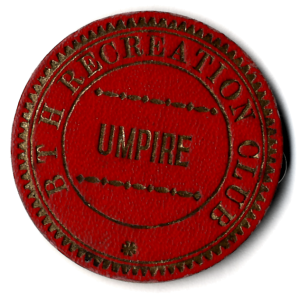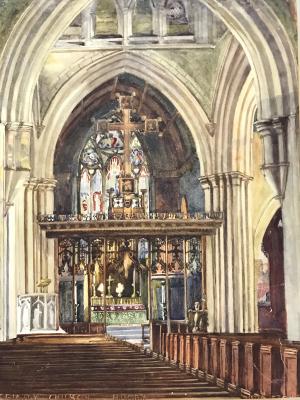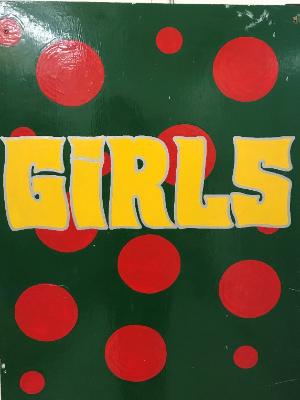Blog - Rugby Art Gallery & Museum

Whilst researching our new social history collection display ‘Join Our Club’ we came across an umpire’s badge for the British Thomson Houston (BTH) Recreation Club. BTH was an electrical engineering company which came to Rugby in 1896 and by the Second World War were employing around 17,000 local people. With this much invested in a local workforce it was important to keep staff...

This month’s object of the month is a watercolour painting which has recently been donated by family members to the museum’s social history collection. It features an interior view of Holy Trinity Church which was on Church Street, Rugby. Holy Trinity was designed by architect Sir George Gilbert Scott. It was built between 1852- 1854 and closed in 1974 before being demolished in 1983. The...

This month’s object of the month is a fantastically colourful door panel from our ‘Every Object Tells A Story’ exhibition. Here’s what Phil Godden, former co-owner The Flying Teapot Café, said about it: “The Flying Teapot Café was situated at the top of Lawford Road. We opened in the mid-1990s, the teapot was a café by day, serving fry ups and milkshakes, with MTV playing on TVs suspended in...
Mast Earth/Isolation Board I remember this mast safety board from when I started at Rugby Radio Station as a Youth-in-Training (Apprentice) in 1964. This board was then still in use to inform all riggers and engineers of which masts were safe to work on. The board was attached to the wall near the South exit of the transmitter hall. It has a rotating indicator for each mast which shows...
Many thousands of fired clay tiles were used in buildings in the Roman settlement of Tripontium. Vast numbers of tile fragments and some complete examples were recovered during the excavations of Tripontium that took place between 1961 and 2004. Different types of tiles included tegulae (roof tiles), imbraces (long tapering tiles with semi-circular cross-section). There were also tubuli (box...
As part of our next exhibition ‘The Ipcress Style’ with costumes from the recent TV series The Ipcress File set in the 1960s, we’ll also have a small display of Rugby items from this era. Whilst researching this display we came across this photograph of the clocktower in Market Place taken on the 5 July 1961. The clocktower is decorated with garlands and flags. At its base a brass band...
This plate would have stood at what was known as the Crick crossroads of the A428 with the A5 Watling Street (London-Holyhead) road. My first question was ‘Why Dunchurch and not Rugby?’ This led me to believe that it would have been put in place by the Northampton-Dunchurch Turnpike Trust who looked after that road. The style of plate was designed by civil engineer Thomas Telford (1757-1834)...
These cards were sent to Jennie Compton from Frank Burbury (1895 – 1977) while he was serving in the British Army during the First World War. Frank was born in Rugby and started his working life at Rugby School and then worked for British Thomson-Houston. He signed up in September 1914 and served as a private in the Rifle Brigade. Embroidered cards of this kind were a common gift for soldiers...
This month’s object of the month is an aerial photograph of Rugby taken in the early 1970s. It measures approximately one metre wide and is mounted on a heavy board. It is likely to have been produced for a public consultation exhibition about planned changes to the town centre. In this photograph you can see many buildings which have since been demolished. These include the swimming baths...
These small glass light bulbs were made at Mazda lamp works in Rugby. They were subsequently hand painted and used as Christmas decorations by the mother of the person who donated them to the museum. On one of the bulbs the message ‘A Happy Xmas to You All, 1947’ has been painted. British Thomson-Houston (BTH) obtained the General Electric patents for tungsten filaments, and the Mazda...
This piece of green Egyptian porphyry was recently found by our summer placement from Leicester University in a box containing archaeological bulk finds. The bulk finds were excavated by Rugby Archaeological Society from Tripontium, the Romano-British town which was located five miles from present day Rugby. Porphyry is a type of igneous rock containing large-grained crystal. This piece would...
The photograph was taken by B. Morris of 14 High Street, Rugby. Cartes de visite are small photographic portraits mounted on a piece of card, usually about 4.5 x 2.5 inches (11.4 x 6.3cm) in size. They were invented by Parisian photographer Andre Adolphe Eugene Disdéri in 1854. Before 1854, most professional photographers used processes that produced only single copies of photographs and made...
This lock was removed from the front door of Rugby workhouse in Lower Hillmorton Road before the building was demolished. The workhouse opened in June 1819 following an agreement between the ten parishes of the Rugby Union to build a “House of Industry” to accommodate their poor The workhouse was intended to accommodate 120-130 people, although it was only fitted out with 50 beds. The men...
Postcards in a wide variety of forms became increasingly popular from the mid to late nineteenth century. An attractive and relatively inexpensive means of communication, they were slow to take off at first – any messages had to be short, and many senders worried about these messages being so openly visible – but in 1894 the cost of sending a postcard in Britain was set at ½d, and this led to a...
To coincide with our Summer exhibition The Life Behind the Landscape: landscape from the Rugby Collection we caught up with Judith Cowan to find out about her affiliation with Italy, and creating work during a pandemic… Can you tell me about A Memory of a Particular Corner in Rome I created the piece in 1979 whilst on a Gulbenkian Rome Scholarship—it was made trying to understand and...
Showing 21 to 35 of 35 entries.